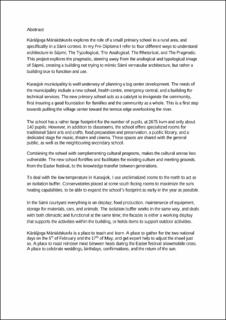| dc.description | Kárášjoga Mánáidskuvla explores the role of a small primary school in a rural area, and specifically in a Sámi context. In my Pre-Diploma I refer to four different ways to understand architecture in Sápmi; The Typological, The Analogical, The Rhetorical, and The Pragmatic. This project explores the pragmatic, steering away from the analogical and typological image of Sápmi, creating a building not trying to mimic Sámi vernacular architecture, but rather a building true to function and use.
Karasjok municipality is well underway of planning a big center development. The needs of the municipality include a new school, health centre, emergency central, and a building for technical services. The new primary school acts as a catalyst to invigorate the community, first insuring a good foundation for families and the community as a whole. This is a first step towards pulling the village center toward the terrace edge overlooking the river.
The school has a rather large footprint for the number of pupils, at 2675 kvm and only about 140 pupils. However, in addition to classrooms, the school offers specialized rooms for traditional Sámi arts and crafts, food preparation and preservation, a public library, and a dedicated stage for music, theatre and cinema. These spaces are shared with the general public, as well as the neighbouring secondary school.
Combining the school with complementing cultural programs, makes the cultural arenas less vulnerable. The new school fortifies and facilitates for existing culture and meeting grounds, from the Easter festival, to the knowledge transfer between generations.
To deal with the low temperature in Karasjok, I use unclimatized rooms to the north to act as an isolation buffer. Conservatories placed at some south facing rooms to maximize the suns heating capabilities, to be able to expand the school’s footprint as early in the year as possible.
In the Sámi courtyard everything is on display; food production, maintenance of equipment, storage for materials, cars, and animals. The isolation buffer works in the same way, and deals with both climactic and functional at the same time; the facades is either a working display that supports the activities within the building, or holds items to support outdoor activities.
Kárášjoga Mánáidskuvla is a place to teach and learn. A place to gather for the two national days on the 6th of February and the 17th of May, and get expert help to adjust the shawl just so. A place to roast reindeer meat between heats during the Easter festival snowmobile cross. A place to celebrate weddings, birthdays, confirmations, and the return of the sun. | en_US |




